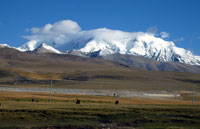China to introduce National Low-carbon Day
(Xinhua) Updated: 2012-09-19 21:07BEIJING - The State Council, or China's cabinet, decided Wednesday to introduce a National Low-carbon Day in a fresh move to cut greenhouse gas emissions in the world's second-largest economy.
The introduction of the National Low-carbon Day beginning 2013 is aimed at promoting awareness about climate change and low-carbon development policies, encouraging public participation and facilitating the country's commitment to reduce greenhouse gas emissions, the State Council said in a statement released after an executive meeting presided over by Premier Wen Jiabao.
The National Low-carbon Day will fall on the third day of the National Energy Efficiency Promotion Week in June every year, according to the State Council.
The idea of establishing the low-carbon day comes at a time when China is working hard to fulfil its commitment to reduce greenhouse gas emissions.
The Chinese government has pledged to cut the energy use per unit of GDP by 16 percent by 2015 from the level in 2011, while lifting non-fossil fuel energy usage to 11.4 percent of the country's total energy consumption from the current 8.6 percent.
To meet the targets, the government has adopted a range of measures, including the closure of outdated thermal power plants and iron and cement workshops and a push for the use of clean energy, such as solar and wind power.
The government hopes to further reduce greenhouse gas emissions per unit of GDP in 2020 by 40 to 45 percent compared to 2005 levels.
At the executive meeting, the State Council also adopted a new sandstorm control plan in north China to minimize dust storms affecting the national capital and neighboring Tianjin Municipality.
The second stage of the sandstorm control project for 2013-2022 will cover 138 counties in Beijing, Tianjin, Hebei, Shanxi, Inner Mongolia and Shaanxi, according to the plan.
Since 2000, the first phase of the sandstorm control project has helped reduce the frequency of sandstorm weather and improve air quality in Beijing and Tianjin, two of the largest cities in northern China, according to the State Council.
The cabinet meeting decided to raise the subsidy standard for some projects of reforesting formerly cultivated land, as of 2013. But the cabinet statement did not disclose the amount of the subsidy.
Under the current reforestation project, the state will subsidize 1,575 yuan (about $248) for every hectare of farmland returning to woodland along the Yangtze River valley and the southern regions as well as 1,050 yuan for per hectare along the Yellow River valley and the northern regions.
According to the State Council, about 9.3 million hectares of farmland returned to forests between 1999 and 2006 after the government launched a national campaign to return farmlands to forests. Around 15 million hectares of hillside was closed to facilitate afforestation during this period.
The State Council urged local governments to continue special programs aimed at improving reforestation and help rural households with their living standards while they return their farmland to forests.
Local authorities should also strengthen management and supervision over afforestation programs to guarantee the quality of engineering projects and ensure special funds in this regard are properly managed.
- 2030 emission goal 'reasonable' - top climate negotiator
- Granting longer visas for foreign experts eyed to ease entry
- Repentant convicts in Xinjiang get sentence reductions
- Tibet hoping to become a top global destination
- Cases of illegal GM crops 'under control'
- Fujian to blaze trail for reforms
- Premier: No giving up on growth
- Planner rules out hard landing
- Diplomacy the key for peaceful coexistence
- Minister: China can absorb laid-off labor







